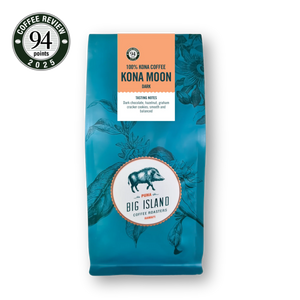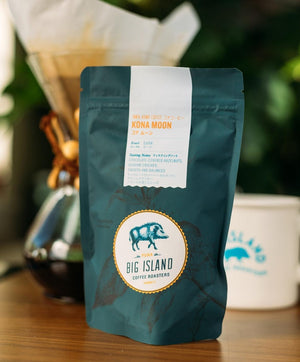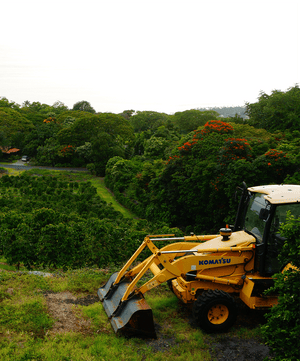Gifting has never been easier
Perfect if you're short on time or are unable to deliver your gift yourself. Enter your message and select when to send it.



Bold yet remarkably smooth, Kona Moon is a dark roast for those who crave depth without bitterness. Grown on a single farm in the Kona District — the same farm as our lighter roast, Kona Bloom — this 100% Kona coffee delivers the rich, chocolatey elegance the region is famed for, with a toasty, sweet finish reminiscent of dark chocolate, hazelnut and graham cracker cookies.
Unlike many dark roasts that lean harsh or smoky, Kona Moon maintains balance and clarity in the cup. Its naturally low acidity and full body make it ideal for espresso, press pot, or a bold drip brew.
What distinguishes Kona Moon is not just the origin — it’s the meticulous refinement behind every batch. After milling, we implement three additional quality steps that elevate this coffee to specialty-grade status
These steps, paired with the hand-harvested ripeness of the Kona cherry, create a coffee free from the imbalances often found in commodity Kona or 10% blends.
Roasted-to-order at our flagship café and roastery in Hilo, Kona Moon represents a darker, richer side of Kona coffee — one that honors the region’s heritage and elevates the standard for dark roasts.
Blind Assessment: Evaluated as espresso. Deep-toned, richly sweet, multilayered. Dark chocolate, vanilla panna cotta, hazelnut, narcissus, pink peppercorn in aroma and small cup. Syrupy-smooth mouthfeel; chocolaty, sweetly nutty finish. In cappuccino format, dessert-like in its chocolaty sweetness, with a hint of pink peppercorn underneath.
Notes: Produced entirely of the Typica variety of Arabica and processed by the washed method (fruit skin and flesh removed from the beans before drying). Big Island Coffee Roasters is an award-winning coffee roaster operated with hands-on passion by Kelleigh Stewart and Brandon von Damitz.
HOLIDAY SHIPPING NOTICE:
Last day to order for guaranteed Christmas delivery via FedEx is 12/14
| Order | Cost & Carrier | Delivery |
|---|---|---|
| ≤$89 | $10.95 via USPS/FedEx | 6-9 days* |
| Over $89 | Free FedEx (USPS if PO Box) | 4-6 days* |
| Expedited | $24.95 via FedEx 2Day | 3-5 days** |
* Delivery quote excludes weekends/holidays and is based on fulfillment+delivery times. Does not include delays that are caused by carrier or out of our control.
** Upgraded and expedited shipping may be purchased at the time of checkout. ‘Expedited’ prioritizes your shipment in the queue. Delivery quote excludes weekends/holidays and is based on fulfillment+delivery times.
Orders are roasted Sunday-Friday and shipped Monday-Friday. Roast dates are applied to the bags in your order.
*Rural locations may incur additional fees at checkout.
| Hawaii to Canada* | Varies based on Territory |
|---|---|
| Up to 1 lb: | $17.29-$18.58 |
| 2-5 lbs: | $17.35-$25.28 |
| 6-10 lbs: | $21.84-$29.76 |
| 11-15 lbs: | $29.14-$44.21 |
| 16-20 lbs: | $35.76-$48.72 |
| 21-25 lbs: | $42.95-$55.63 |
| 26-30 lbs: | $55.07-$70.03 |
| 31-99 lbs: | $59.63-$125.86 |
| 100+ lbs: | Email for quote |
|
De Minimis for Duty |
De Minimis for VAT |
|---|---|
| $150 CAD | $40 CAD |
|
Hawaii to Germany, United Kingdom* |
|
|---|---|
| Up to 1 lb: | $17.62 |
| 2-5 lbs: | $17.64-$25.22 |
| 6-10 lbs: | $25.67-$29.08 |
| 11-15 lbs: | $41.44-$50.04 |
| 16-20 lbs: | $53.98-$58.28 |
| 21-25 lbs: | $61.46-$62.84 |
| 26-30 lbs: | $83.21-$88.46 |
| 31-99 lbs: | $90.07-$165.31 |
| 100+ lbs: | Email for quote |
| De Minimis for Duty | De Minimis for VAT |
|---|---|
| 150 EUR | 22 EUR |
| 135 GBP | 15 GBP |
|
Hawaii to Japan, South Korea* |
|
|---|---|
| Up to 1 lb: | $17.64 |
| 2-5 lbs: | $20.93-$31.81 |
| 6-10 lbs: | $34.32-$41.56 |
| 11-15 lbs: | $43.99-$53.74 |
| 16-20 lbs: | $53.84-$61.03 |
| 21-25 lbs: | $63.48-$67.64 |
| 26-30 lbs: | $75.35-$92.33 |
| 31-99 lbs: | $94.17-$189.94 |
| 100+ lbs: | Email for quote |
| De Minimis for Duty | De Minimis for VAT |
|---|---|
| 10,000 JPY | 200,999 JPY |
| 150,000 KRW** | 150,000 KRW |
| ** price of goods+shipping cost+insurance | |
| Hawaii to Australia* *Rural locations may incur additional costs at checkout |
|
|---|---|
| Up to 1 lb: | $20.70 |
| 2-5 lbs: | $22.16-$30.40 |
| 6-10 lbs: | $29.33-$36.40 |
| 11-15 lbs: | $55.54-$72.31 |
| 16-20 lbs: | $76.98-$85.37 |
| 21-25 lbs: | $91.27-$93.29 |
| 26-30 lbs: | $122.59-$126.73 |
| 31-99 lbs: | $126.77-$245.34 |
| 100+ lbs: | Email for quote |
| De Minimis for Duty | De Minimis for VAT |
|---|---|
| 1000 AUD | None |
* Please note that customs and duties are displayed at checkout. All costs listed are estimates.
Because Espresso Bites are made without stabilizers or preservatives, they may bloom or melt when shipping temperatures exceed 80 F. If this is a concern in your location please select FedEx shipping.
If you notice a white color to your bar, it's perfectly safe to eat. This happens when the cocoa butter softens and migrates to the surface. It happens more often when shipping in warm weather. Learn more about blooming.
Espresso Bites that melt or bloom when shipped via FedEx are eligible for a full refund or credit.
Espresso Bites that melt or bloom when the buyer elects Free Shipping or standard USPS are eligible for a credit.
If your order is incorrect or damaged in any way, please email us at hello@bigislandcoffeeroasters.com with your order number within 7 days of receiving your order.
Big Island Coffee Roasters, 76 Kalanianaole St. Hilo, HI 96720
Watch our step by step guide on how to brew Kona Peaberry coffee with a Hario V60.
What you'll need:
Kettle
Scale
Burr Grinder
Coffee Dripper (Hario V60, etc...)
Kona Peaberry
For coffee connoisseurs, Kona coffee is one of the best-tasting coffees in the world. But what makes it so delicious is what also makes it expensive, such as the precise balance of climate, weather and soil. After all, Kona coffee is only grown in the rich soil of the Big Island -- and only 100 percent Kona coffees are able to be called "Kona."
1. Kona Coffee Is 100% Pure
Like certain spirits that only come from a specific region of the world, Kona coffee has many imitators but no equals. In fact, Kona coffees that are mixed with other coffees are actually called Kona blends, but it says nothing about how much Kona coffee is found inside. Some unscrupulous sellers may only have trace amounts of Kona coffee within.
While many might think that a Kona blend is an amalgamation of different Kona coffees, it actually means that only about 10 percent of the blend is Kona. As to what's in the remaining 90 percent, it's safe to say that it's likely whatever else they could get their hands on. That means the first requirement for a great-tasting cup of Kona coffee is a 100 percent Kona coffee -- no blends or imitations need apply.
2. The Kona Coffee Belt Is the Perfect Place To Grow Coffee
With over 200 years of history in Hawaii, Kona coffee has found an ideal home in the volcanic hills of the Kona region. With a mix of sunshine and shade, as well as comfortable temperatures during the day and night, Kona coffee gets just the right climate to get the most out of the Kona coffee bean.
High altitudes also give Kona coffee its distinctive yet mild taste, and regular rains make sure that the plants don't dry out or get too warm in the Hawaii sun. The porous, volcanic soil is also ideal for quickly wicking away excess water. Taken all together, it's this ideal mix that helps Kona coffee dial up the rich flavor.
3. Dark Roast Kona Coffees Are Full of Bold Flavors
Unlike light and medium roasts that provide a subtle and complex flavor, dark roast Kona coffees, like other dark roast coffees, are full-bodied and bold with a straight flavor profile and low acidity that is great for mixing with milks and creams and suits the preferences of most coffee drinkers.
If, on the other hand, you prefer more subtle notes in the coffee you drink, you may enjoy a medium or light roast.
Comparing the Different Types of Kona Coffee
As mentioned earlier, not all Kona coffees are the real deal.
A Kona roast has the least to do with real Kona coffee, and likely contains no Kona coffee inside at all. There's really no such thing as a Kona roast from a manufacturing perspective, and unsavory sellers have started to cash in on the Kona name with so-called "Kona blends." Suffice it to say that this term is about as valuable as the paper it's written on.
Similarly, Kona style is another faux brewing term that is being used today to sell lesser coffee beans and roasts. Unless it mentions the amount of Kona coffee included (commonly 10 or 100 percent), there's likely no Kona coffee within.
Kona blends tend to only have 10 percent Kona coffee, a legal requirement that mandates that any Kona blend maintain at least a 10 percent mixture of real Kona coffee. While Kona blends may contain more than 10 percent Kona coffee, they rarely, if ever, do so.
By comparison, 100 percent Kona coffee contains only Kona coffee beans with no exceptions or substitutions.
The Stages of Coffee Roasting
Straight from the coffee plant, coffee beans are more green than the tans and browns you're likely used to. That's because the roasting process is used to add complex flavors to the coffee beans -- flavors that will be released again during the brewing process. In fact, you can try your hand at roasting coffee at home if you purchase raw coffee beans.
For most, they choose to leave it up to the professionals, which roast coffee beans in either a drum or hot-air roaster. The first stage of roasting brings the coffee bean to a light pale or white. No changes have yet taken place chemically, but under heat the color starts to shift.
In the second stage of roasting, the coffee beans shift into an orange or tan color in addition to undergoing caramelization. From a more grassy smell to a sweeter, more savory smell, roasting continues until it hits the third stage, which is accompanied by an audible crack that denotes a "light roast."
In the fourth stage of roasting up until the second crack, tastes are shifting wildly as the roasting process imparts more flavor and richness. Removing the coffee beans from the roasting process after the first crack but before the second gives you a medium roast, while removing the beans after the second crack denotes dark roast coffee.
Watch our step by step guide on how to brew Kona Peaberry coffee with a Hario V60.
What you'll need:
Kettle
Scale
Burr Grinder
Coffee Dripper (Hario V60, etc...)
Kona Peaberry
For coffee connoisseurs, Kona coffee is one of the best-tasting coffees in the world. But what makes it so delicious is what also makes it expensive, such as the precise balance of climate, weather and soil. After all, Kona coffee is only grown in the rich soil of the Big Island -- and only 100 percent Kona coffees are able to be called "Kona."
1. Kona Coffee Is 100% Pure
Like certain spirits that only come from a specific region of the world, Kona coffee has many imitators but no equals. In fact, Kona coffees that are mixed with other coffees are actually called Kona blends, but it says nothing about how much Kona coffee is found inside. Some unscrupulous sellers may only have trace amounts of Kona coffee within.
While many might think that a Kona blend is an amalgamation of different Kona coffees, it actually means that only about 10 percent of the blend is Kona. As to what's in the remaining 90 percent, it's safe to say that it's likely whatever else they could get their hands on. That means the first requirement for a great-tasting cup of Kona coffee is a 100 percent Kona coffee -- no blends or imitations need apply.
2. The Kona Coffee Belt Is the Perfect Place To Grow Coffee
With over 200 years of history in Hawaii, Kona coffee has found an ideal home in the volcanic hills of the Kona region. With a mix of sunshine and shade, as well as comfortable temperatures during the day and night, Kona coffee gets just the right climate to get the most out of the Kona coffee bean.
High altitudes also give Kona coffee its distinctive yet mild taste, and regular rains make sure that the plants don't dry out or get too warm in the Hawaii sun. The porous, volcanic soil is also ideal for quickly wicking away excess water. Taken all together, it's this ideal mix that helps Kona coffee dial up the rich flavor.
3. Dark Roast Kona Coffees Are Full of Bold Flavors
Unlike light and medium roasts that provide a subtle and complex flavor, dark roast Kona coffees, like other dark roast coffees, are full-bodied and bold with a straight flavor profile and low acidity that is great for mixing with milks and creams and suits the preferences of most coffee drinkers.
If, on the other hand, you prefer more subtle notes in the coffee you drink, you may enjoy a medium or light roast.
Comparing the Different Types of Kona Coffee
As mentioned earlier, not all Kona coffees are the real deal.
A Kona roast has the least to do with real Kona coffee, and likely contains no Kona coffee inside at all. There's really no such thing as a Kona roast from a manufacturing perspective, and unsavory sellers have started to cash in on the Kona name with so-called "Kona blends." Suffice it to say that this term is about as valuable as the paper it's written on.
Similarly, Kona style is another faux brewing term that is being used today to sell lesser coffee beans and roasts. Unless it mentions the amount of Kona coffee included (commonly 10 or 100 percent), there's likely no Kona coffee within.
Kona blends tend to only have 10 percent Kona coffee, a legal requirement that mandates that any Kona blend maintain at least a 10 percent mixture of real Kona coffee. While Kona blends may contain more than 10 percent Kona coffee, they rarely, if ever, do so.
By comparison, 100 percent Kona coffee contains only Kona coffee beans with no exceptions or substitutions.
The Stages of Coffee Roasting
Straight from the coffee plant, coffee beans are more green than the tans and browns you're likely used to. That's because the roasting process is used to add complex flavors to the coffee beans -- flavors that will be released again during the brewing process. In fact, you can try your hand at roasting coffee at home if you purchase raw coffee beans.
For most, they choose to leave it up to the professionals, which roast coffee beans in either a drum or hot-air roaster. The first stage of roasting brings the coffee bean to a light pale or white. No changes have yet taken place chemically, but under heat the color starts to shift.
In the second stage of roasting, the coffee beans shift into an orange or tan color in addition to undergoing caramelization. From a more grassy smell to a sweeter, more savory smell, roasting continues until it hits the third stage, which is accompanied by an audible crack that denotes a "light roast."
In the fourth stage of roasting up until the second crack, tastes are shifting wildly as the roasting process imparts more flavor and richness. Removing the coffee beans from the roasting process after the first crack but before the second gives you a medium roast, while removing the beans after the second crack denotes dark roast coffee.
Gifting has never been easier
Perfect if you're short on time or are unable to deliver your gift yourself. Enter your message and select when to send it.